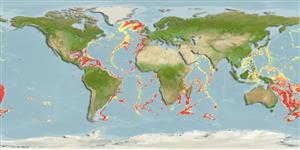>
Ophidiiformes (Cusk eels) >
Bythitidae (Livebearing brotulas)
Etymology: Aphyonus: Greek, aphyes = sardine + Greek, onos = hake.
More on author: Günther.
Environment: milieu / climate zone / depth range / distribution range
Ecología
marino batidemersal; rango de profundidad 625 - 2560 m (Ref. 105129). Deep-water
Indo-West Pacific: from off East Africa eastwards to Japan and New Zealand and in the Atlantic Ocean.
Tamaño / Peso / Age
Maturity: Lm ? range ? - ? cm
Max length : 15.0 cm SL macho / no sexado; (Ref. 7408); 14.8 cm SL (female)
Radios blandos dorsales (total): 92-118; Radios blandos anales: 61 - 78. This species is distinguished by the following characters: with joined vertical fins and loose, transparent, scaleless skin; body depth at origin of anal fin 13.0-16.5% SL; eyes are small or not externally visible; mouth almost horizontal; upper jaw ends well behind the eye; palatines edentate; jaws with small blunt or pointed teeth, no fangs; vomer with 3-7 fangs; anterior gill arch with 3-4 long rakers; D 92-118; A 61-78; pectoral fin 17-20 rays, with peduncle as long as or a little longer than high; pelvic fin with one ray; caudal fin rays 6-8; precaudal vertebrae 28-33, total vertebrae 77-87; vertebral centra in adults almost rectangular in lateral view; vertebrae generally poorly ossified; sagittal otolith rather large, oval and thin; penis partly covered ventrally by genital hood that ends in a medially placed clasper ventral to penis; no paired claspers in both sexes; fresh specimens with black peritoneum (Ref. 105129).
Found on or near bottom (Ref. 6527). The well-developed penis and reported presence of numerous spermatophores in histologically examined testes indicate internal fertilization. Eggs are found up 1 mm in diameter, but embryos were not observed (Ref. 105129). Uncommon species (Ref. 34024).
Life cycle and mating behavior
Madurez | Reproducción | Puesta | Huevos | Fecundidad | Larva
Nielsen, J.G., 2015. Revision of the aphyonid genus Aphyonus (Teleostei: Ophidiiformes) with a new genus and two new species. Zootaxa 4039(2):323-344. (Ref. 105129)
IUCN Red List Status (Ref. 130435)
Threat to humans
Harmless
Human uses
Pesquerías: sin interés
Más información
ReferenciasAcuiculturaPerfil de acuiculturaRazasGenéticaElectrophoresesheritabilidadEnfermedadesProcesamientoNutrientsMass conversion
ColaboradoresImágenesStamps, Coins Misc.SonidosCiguateraVelocidadTipo de nataciónSuperficie branquialOtolitosCerebrosVisión
Herramientas
Warning: mysqli::__construct(): (HY000/1040): Too many connections in /var/www/html/includes/speciessummary.lib.php on line 2414
Can't connect to MySQL database fbquizv2. Errorcode: Too many connections
